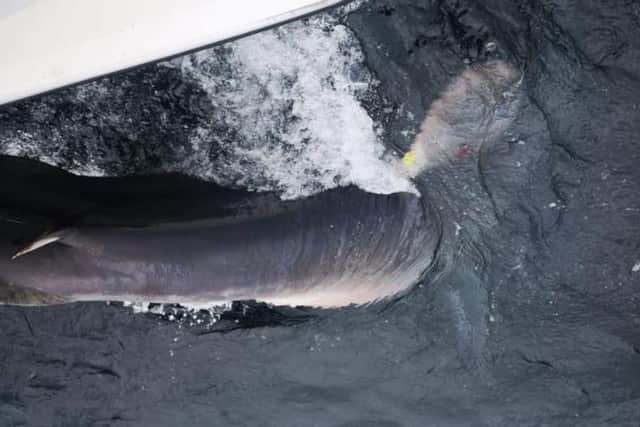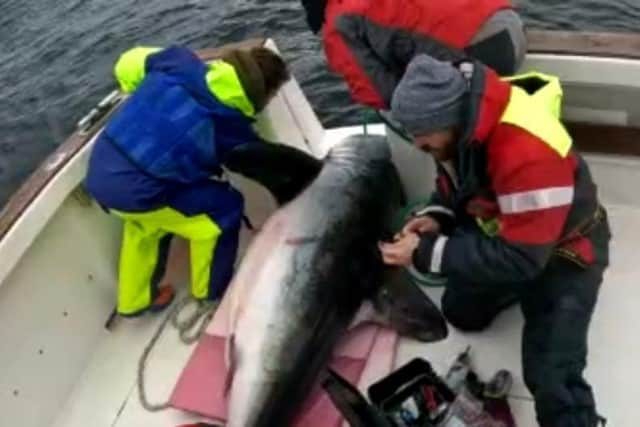Danu, 'largest ever porbeagle' - relative of Great White - tagged off Donegal
and live on Freeview channel 276
Anglers (Sid, Terry, and Peter from Counties Cork, Down and Antrim, respectively) worked together to catch the giant 'porgie' and transfer it to a scientific vessel where it was measured and tagged.
Scientists led by Trinity College Dublin tagged and released the record-breaking 2.8 m porbeagle shark, Lamna nasus, last week.
Advertisement
Hide AdAdvertisement
Hide AdThe huge female specimen of the porbeagle - a relative species to the Great White - was estimated to weigh 400-500 lb and thought to be 25-30 years old.


This is the largest ever recorded in Irish waters
Nick Payne, shark biologist and Assistant Professor in Trinity’s School of Natural Sciences, said: “It is exciting to see such huge porbeagles in Irish waters. The conservation status of porbeagles has been really concerning in this part of the world, with the European population considered critically endangered.
"There’s evidence that the Donegal coast may act as a globally important reproductive area for this species, with lots of very large female sharks appearing here for a short period in Spring.”


Last week was the first trip in a new research collaboration between Trinity, Inland Fisheries Ireland (IFI), and local shark anglers, together with leading scientists from James Cook University (Australia), University of Miami, and US non-profit Beneath the Waves.
Advertisement
Hide AdAdvertisement
Hide AdDr Payne added: “This was an incredible start to an important new project, where we will work with the local shark angling community to learn as much as we can about porbeagle movements and their reproductive dynamics in Irish waters.
"If this is an important breeding location then we need to know about it, so we can monitor and conserve the animals as best we can when they visit our shores.”
Jenny Bortoluzzi, PhD candidate in Trinity’s School of Natural Sciences, took blood samples from the shark.
She said: “This highlights once again both the importance of collaboration between scientists and anglers in a citizen science context, and Ireland’s potential key role in conservation as a marine biodiversity hotspot.”
Advertisement
Hide AdAdvertisement
Hide AdOverfishing saw severe declines in porbeagle stocks since the 1930s, and commercial fishing by EU vessels has been prohibited under EU regulations since 2010.
The International Council for Exploration of the Sea considers there to be just a single stock in the Northeast Atlantic, with tagging data showing individual porbeagle sharks can migrate long distances throughout the region.
“If we are to see recovery of the European porbeagle population it is especially important to monitor reproductive areas. If Ireland is a key breeding site then we really have a global responsibility to protect porbeagles using this area,” Dr Payne said.
Willie Roche, IFI Senior Scientist, echoed those thoughts.
Advertisement
Hide AdAdvertisement
Hide AdHe said: “Understanding the movements and migrations of porbeagles, especially large females which we are targeting for tagging, will contribute immensely to identifying potential challenges to their continued survival, as well as piecing together their seasonal patterns.
“The satellite tagging data is complemented by IFI’s long running Marine Sportfish Tagging Programme, which uses conventional tags to tag mainly elasmobranchs. The role of anglers in both these tagging initiatives highlights the importance of their contribution to targeted tagging studies and, as active marine environment observers, to ongoing monitoring of elasmobranch species generally.”
The shark, which the team have nicknamed Danu, was handled and tagged safely and released in a healthy condition. One of her satellite tags will transmit a wealth of information to satellite on her migration history and ocean conditions encountered, before detaching in several months.
